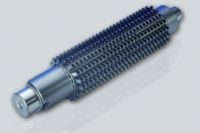SpeedCore Allows for More Efficient and Flexible Hobbing

In today's gear manufacturing environment, flexibility and efficiency are key factors in modern machine tool technology. Productivity improvements, including state-of-the-art gear cutting machine tools, allow higher cutting speeds by up to 30 percent. While most of the machines are already designed to utilize carbide hobs and work under dry conditions, the newly developed material SpeedCore by LMT Fette, is now at the stage to accelerate the machining conditions dramatically-for the benefit of the customer.
"The core of the new SpeedCore material is made out of carbon-free iron, cobalt and Molybdenum," says LMT Tool Systems' Thomas Falk. "This new composition as well as the powder metallurgy manufacturing method allows an increase in high temperature hardness of the material compared to the traditional PM-HSS materials. The hardness of this material is generated by special nanostructures, which are in an intermetallic state."
Higher cutting speeds increase the mechanical and thermal loads of the hob. While HSS materials are limited to a range of cutting speeds due to their limited high temperature hardness, SpeedCore hobs from LMT Fette are manufactured out of this new cutting material, which overcomes the barriers of high temperature hardness while at the same time offering sufficient toughness. "With hobs using the new SpeedCore material, the cutting speed increases, the customer gains significantly more parts in less time and the machine tools will be utilized more efficiently," Falk adds. "Nearly no additional investment is necessary to increase the productivity, just the new SpeedCore material."
LMT Fette has tested the capability with the support of the Technical University of Magdeburg. The newly developed material was tested at cutting conditions normally used for solid carbide hobs. The results prove the high temperature resistance of SpeedCore. In the laboratory tests machining real components, the SpeedCore materials were used at cutting speeds up to 350 m/min without any thermal overload of the cutting edge. The tool length achieved 7 m; these are conditions where PM-HSS materials would fail. In real-world applications, these results in the manufacturing environment mean customers can increase the cutting speed more than 30 percent to improve the efficiency of the gear cutting process. There are two options: the cutting speed is increased to achieve a predetermined tool life, or the process is adjusted to the capability of the SpeedCore material. The customer will achieve in both cases lower costs per workpiece.
The launch of the new cutting material means LMT has taken another step in developing its gear-wheel production system. Following the Nanosphere coating, launched less than two years ago, the SpeedCore cutting material is another technological breakthrough. The LMT hob cutter system includes not only coatings and cutting materials, but also application-specific engineering and services likes LMT's global reconditioning and coating network. Its centers in China, Germany and the United States enable LMT to guarantee it will recondition hobs to original manufacturer quality for users worldwide. The new hob generation was officially launched in Germany in June as part of a specialist gear-cutting symposium in Schwarzenbek. "SpeedCore made its international debut at EMO Hannover in September, where we also introduced the start of a much larger product range," Falk says.
LMT Fette is also presenting a new cutting material at EMO Hannover that has been specially developed by its alliance partner Boehlerit for milling applications. Nanosilver, a nanostructured coating, has been applied to three new carbide substrates. The new TeraSpeed coating substantially improves the performance of LMT indexable inserts. The aluminum titanium nitride coating system offers a high level of thermal resistance of up to 1,100 degrees Celsius-200 degrees higher than comparable coatings. The XChange threading tap combines the advantages of carbide and high-speed steel: equipped for internal cooling, the tool is capable of twice the cutting speed of a conventional HSS tap. LMT is presenting a coating for thread rollers in the shape of Protec, an innovation that will expand the range of thread-rolling applications. The elastic and flexible thin-film coating has been specially designed for processing hard materials and increases tool life by up to 30 percent. In addition, LMT is pooling more than 50 years of experience in the machining of composite materials as part of its Composite Excellence initiative.
The main focus at EMO, however, was on SpeedCore and its various advantages, including higher productivity, higher operating safety, easy implementation on older machines and the resharpening and recoating options available.
"Speedcore has been incredibly successful in applications regarding productivity and tool life," Falk says. "The target is the increase of productivity in the gear wheel production and to guarantee a process security."





